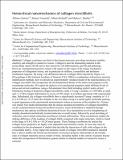Hierarchical nanomechanics of collagen microfibrils
Author(s)
Gautieri, Alfonso; Vesentini, Simone; Redaelli, Alberto; Buehler, Markus J
DownloadBuehler_Hierarchical nanomechanics.pdf (2.228Mb)
PUBLISHER_POLICY
Publisher Policy
Article is made available in accordance with the publisher's policy and may be subject to US copyright law. Please refer to the publisher's site for terms of use.
Alternative title
Hierarchical structure and nanomechanics of collagen microfibrils from the atomistic scale up
Terms of use
Metadata
Show full item recordAbstract
Collagen constitutes one-third of the human proteome, providing mechanical stability, elasticity, and strength to organisms and is the prime construction material in biology. Collagen is also the dominating material in the extracellular matrix and its stiffness controls cell differentiation, growth, and pathology. However, the origin of the unique mechanical properties of collagenous tissues, and in particular its stiffness, extensibility, and nonlinear mechanical response at large deformation, remains unknown. By using X-ray diffraction data of a collagen fibril (Orgel, J. P. R. O. et al. Proc. Natl. Acad. Sci. 2006, 103, 9001) here we present an experimentally validated model of the nanomechanics of a collagen microfibril that incorporates the full biochemical details of the amino acid sequence of constituting molecules and the nanoscale molecular arrangement. We demonstrate by direct mechanical testing that hydrated (wet) collagen microfibrils feature a Young’s modulus of ≈300 MPa at small, and ≈1.2 GPa at larger deformation in excess of 10% strain, which is in excellent agreement with experimental data. We find that dehydrated (dry) collagen microfibrils show a significantly increased Young’s modulus of ≈1.8−2.25 GPa, which is in agreement with experimental measurements and owing to tighter molecular packing. Our results show that the unique mechanical properties of collagen microfibrils arise due to their hierarchical structure at the nanoscale, where key deformation mechanisms are straightening of twisted triple-helical molecules at small strains, followed by axial stretching and eventual molecular uncoiling. The establishment of a model of hierarchical deformation mechanisms explains the striking difference of the elastic modulus of collagen fibrils compared with single molecules, which is found in the range of 4.8 ± 2 GPa, or ≈10−20 times greater. We find that collagen molecules alone are not capable of providing the broad range of mechanical functionality required for physiological function of collagenous tissues. Rather, the existence of an array of deformation mechanisms, derived from the hierarchical makeup of the material, is critical to the material’s ability to confer key mechanical properties, specifically large extensibility, strain hardening, and toughness, despite the limitation that collagenous materials are constructed from only few distinct amino acids. The atomistic model of collagen microfibril mechanics now enables the bottom-up elucidation of structure−property relationships in a broader class of collagen materials (e.g., tendon, bone, cornea), including studies of genetic disease where the incorporation of biochemical details is essential. The availability of a molecular-based model of collagen tissues may eventually result in novel nanomedicine approaches to develop treatments for a broad class of collagen diseases and the design of de novo biomaterials for regenerative medicine.
Date issued
2011-01Department
Massachusetts Institute of Technology. Center for Computational Engineering; Massachusetts Institute of Technology. Department of Civil and Environmental Engineering; Massachusetts Institute of Technology. Department of Materials Science and Engineering; Massachusetts Institute of Technology. Laboratory for Atomistic and Molecular MechanicsJournal
Nano Letters
Publisher
American Chemical Society
Citation
Gautieri, Alfonso et al. “Hierarchical Structure and Nanomechanics of Collagen Microfibrils from the Atomistic Scale Up.” Nano Letters 11.2 (2011): 757–766. CrossRef. Web.
Version: Author's final manuscript
ISSN
1530-6984
1530-6992